How to Identify and Treat Dollar Spot Disease in Your Maryland Lawn
Green. Dark, rich, emerald green. That’s the color you want.
We get it. That’s the expectation for a healthy lawn.
But beige or tan spots that don’t go away or just keep getting bigger and bigger are not what you crave. These spots you’re seeing that are ruining your perfect lawn may be caused by a fungal disease called dollar spot.
Let’s look at what dollar spot is, what causes it, and how to treat dollar spot so you can get your green, thick lawn back.
Dollar Spot Lawn Disease in Maryland
Seeing beige circles in your lawn is certainly troubling.
But knowing how to identify what’s causing these spots can ensure you treat it properly and don’t cause any further lawn damage.
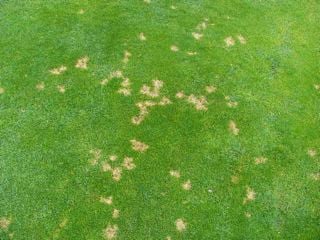
If dollar spot fungus is the cause, you’ll want to get ahead of it to avoid it from spreading across your lawn.
What is Dollar Spot Lawn Disease?
What causes dollar spot lawn disease is a pathogen called Clarireedia jacksonii.
This lawn disease appears as tan spots that are 2 to 6 inches in diameter in late spring and early summer when temperatures are between 60 degrees and 90 degrees Fahrenheit. Since these spots are the size of silver dollars, this is where the disease gets its name.
Since quite a few things that impact lawns can cause dead spots, you’ll want to take a closer look to identify dollar spot. Grass blades infected with the disease will have hourglass-shaped lesions with bleached centers and reddish-brown borders. Grass blades will slowly die as the lesions grow.
You can also look for a material called mycelium in the infected areas. This web-like coating has a silvery appearance. You have the best chance of spotting it in the early morning hours when dew is still on your lawn.
What Causes Dollar Spot?
In Maryland, any lawn can be susceptible to dollar spot lawn disease.
For the disease to develop though, you need the right environmental conditions. Dollar spot thrives in poorly managed lawns – those with low mowing heights, dry soils, and low nitrogen levels. The pathogen grows when days are warm, nights are cool, and dew is heavy; this leads to high humidity and long periods of wet grass blades (about 10 to 12 hours).
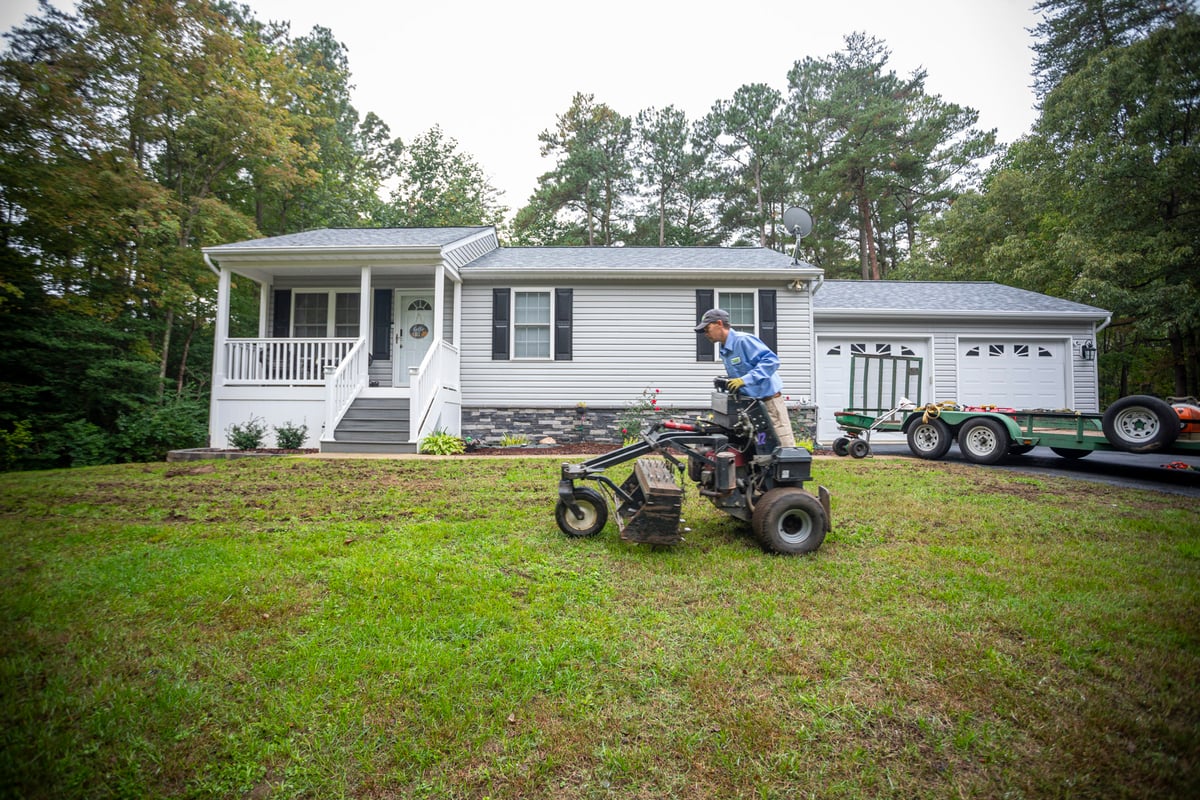 If your lawn hasn’t been aerated in awhile, it could also have excessive thatch build-up. Dollar spot will have a better chance of growing in these conditions. Lawns with wet autumn leaves on them are also more prone to dollar spot.
If your lawn hasn’t been aerated in awhile, it could also have excessive thatch build-up. Dollar spot will have a better chance of growing in these conditions. Lawns with wet autumn leaves on them are also more prone to dollar spot.
You can spread the disease through lawn mowers or other equipment, with infected grass clippings, or even with your shoes. Wind and animals can also move the disease around.
How to Treat Dollar Spot
Some of the factors that can cause dollar spot fungus, like humid, wet weather, are out of your control. You can’t change Mother Nature.
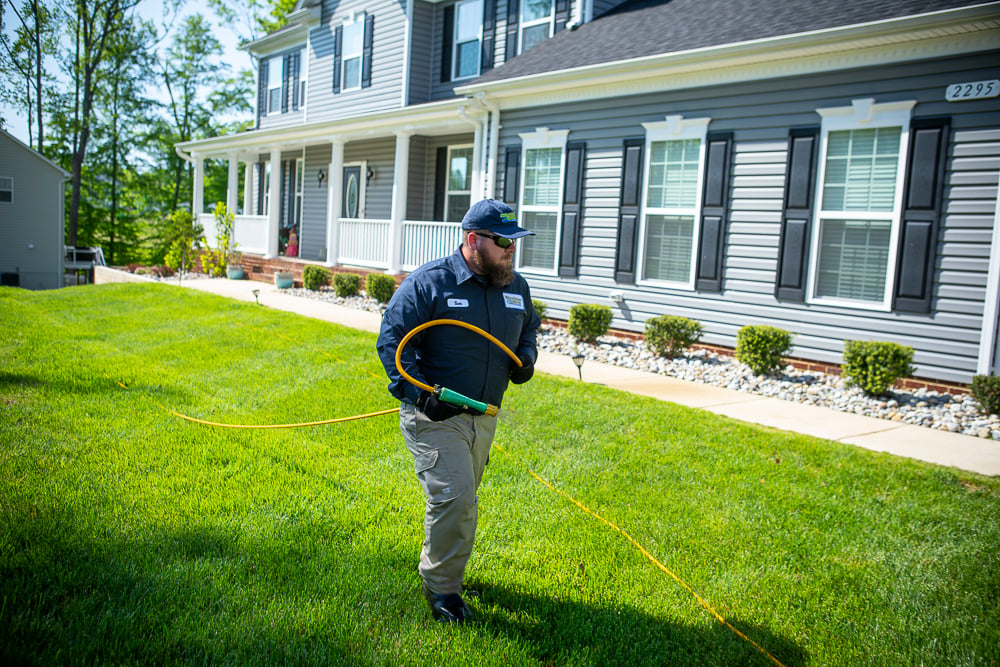 If you ignore the disease and don’t implement a treatment plan, however, dollar spot lawn disease will spread, merging these circular patches into large areas of dead grass.
If you ignore the disease and don’t implement a treatment plan, however, dollar spot lawn disease will spread, merging these circular patches into large areas of dead grass.
Use This Tool to Compare Your Local Lawn Care Companies
Preventing and treating this disease is possible with some proper lawn care and treatments for breakthrough infections.
Good Lawn Care Helps Defend Your Lawn Against Dollar Spot
By keeping preventive measures at the top of your lawn care to-do list, you can keep dollar spot away. In fact, some simple steps can not only boost your lawn’s appearance and health, but also enable it to better fight disease.
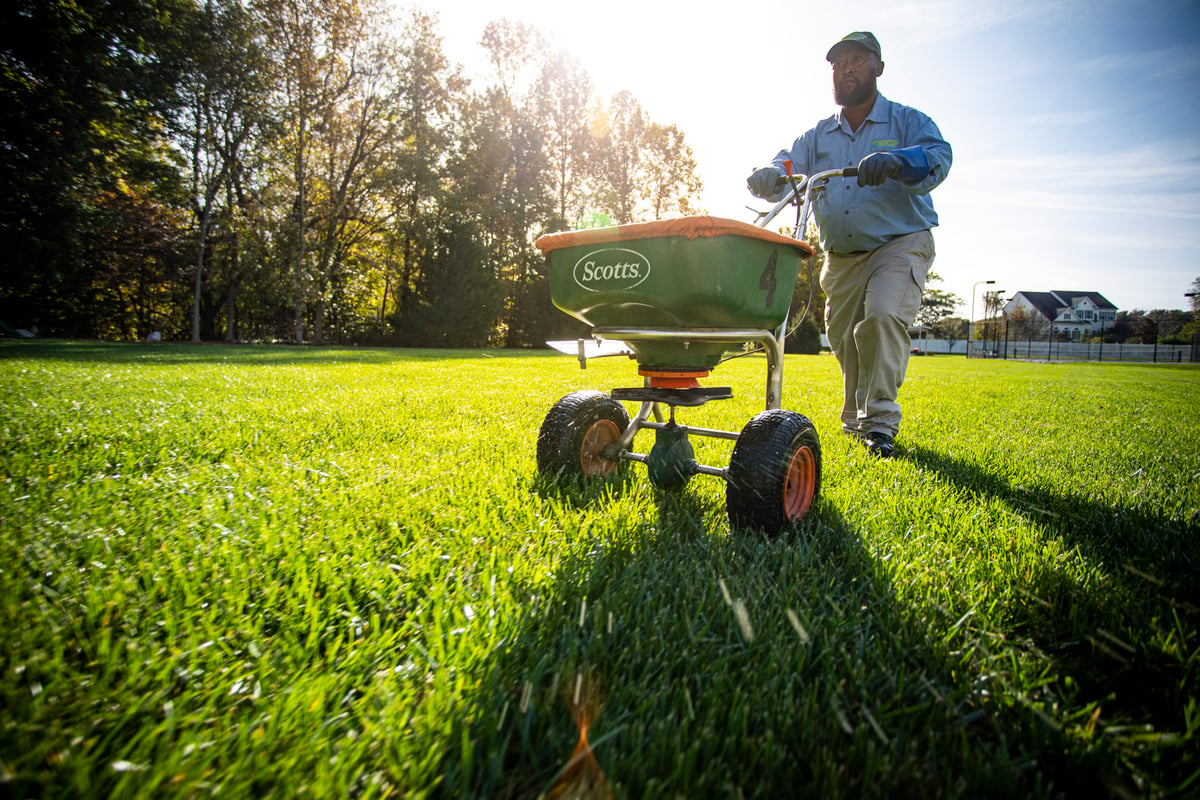 Here are some basic tasks to consider implementing:
Here are some basic tasks to consider implementing:
- Don’t over- or under-water. You want your lawn to dry out before nightfall, preventing long periods of wet grass. Watering during early morning hours helps.
- Encourage airflow. Autumn aeration helps increase airflow and reduce thatch in your lawn. Overseeding at this time also thickens your lawn to fill in bare spots. All of these things encourage disease prevention.
- Fertilize correctly. A soil test can determine what your lawn is lacking. Fertilizing based on these results ensures your lawn receives the right doses of nutrients throughout the year. You don’t want to neglect fertilization because a lack of nutrients, particularly nitrogen, can encourage dollar spot growth. Proper fertilization reduces the chances of dollar spot, while environment is the typical driver of this disease.
- Mow properly. When you cut your lawn too short or cut off too much at any one time, you stress it out, which can give disease a chance to strike. Maintaining a 3.5- to 4-inch height is best. Weekly mowing during the growing season ensures you never trim more than one-third of the grass blades at any one time.
Fungicide Treatment Options
For severe dollar spot fungus infections, you may need to call in a lawn care pro for a fungicide treatment.
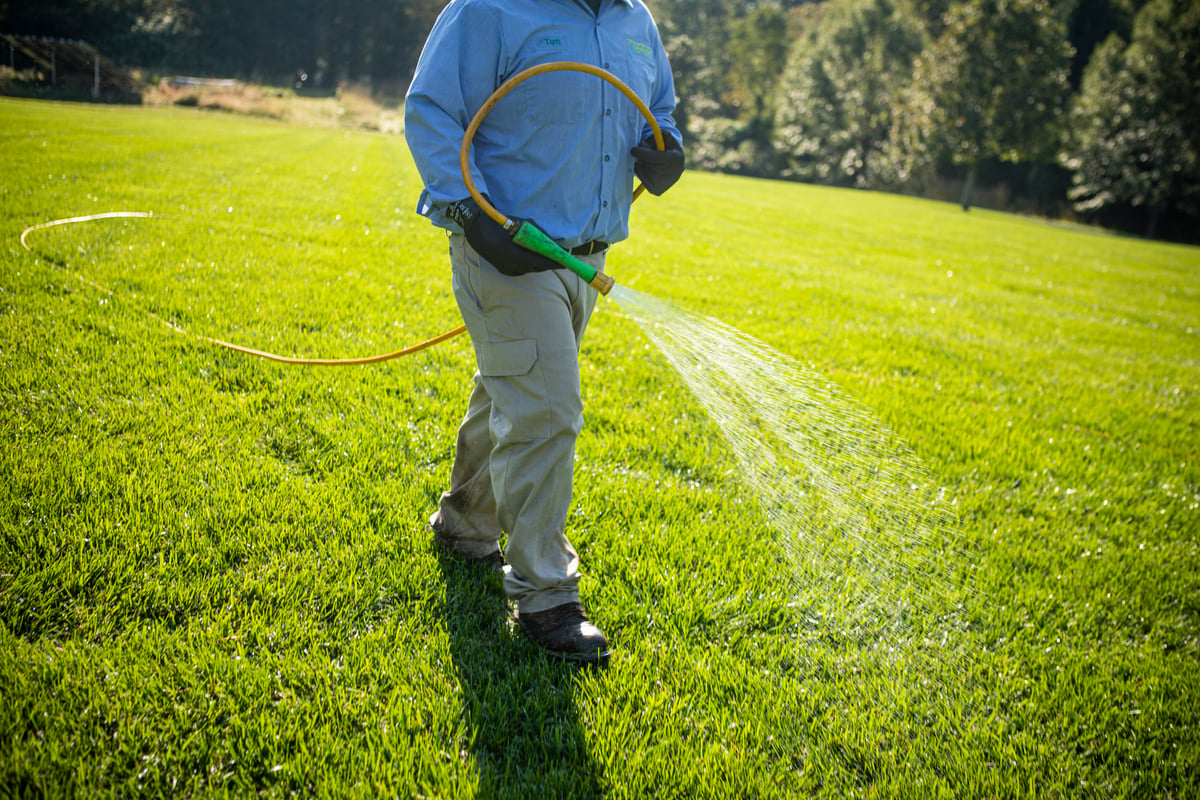 Because of dollar spot’s ability to rapidly spread, if you have ignored the spots, conditions in your lawn haven’t improved, and the disease has grown out of control, this may be an option for you to consider to get your lawn back.
Because of dollar spot’s ability to rapidly spread, if you have ignored the spots, conditions in your lawn haven’t improved, and the disease has grown out of control, this may be an option for you to consider to get your lawn back.
Stop Seeing Spots in Your Maryland Lawn
Maintaining your lawn is always the best way to keep disease from erupting in your lawn. And if you do spot some disease symptoms, proper care can help take them away.
But if conditions are prime for disease growth, you might find yourself seeing straw-colored spots in your lawn that look like dollar spot fungus.
Whatever you do, don’t panic. If you don’t see the spots going away – or worse, you see them growing – don’t fret. Give Natural Green’s experts a call. We can easily and quickly identify this lawn disease in Central and Southern Maryland lawns and swiftly give you guidance on how to control it, recommending a treatment plant that works best for you.
Is dollar spot making you see circles in your lawn? We’d love to help. Get started today with a free quote. Together, we’ll prepare a customized plan for your Central or Southern Maryland lawn so you can make an educated decision.
Image Source: Dollar Spot
Green. Dark, rich, emerald green. That’s the color you want.
We get it. That’s the expectation for a healthy lawn.
But beige or tan spots that don’t go away or just keep getting bigger and bigger are not what you crave. These spots you’re seeing that are ruining your perfect lawn may be caused by a fungal disease called dollar spot.
Let’s look at what dollar spot is, what causes it, and how to treat dollar spot so you can get your green, thick lawn back.
Dollar Spot Lawn Disease in Maryland
Seeing beige circles in your lawn is certainly troubling.
But knowing how to identify what’s causing these spots can ensure you treat it properly and don’t cause any further lawn damage.

If dollar spot fungus is the cause, you’ll want to get ahead of it to avoid it from spreading across your lawn.
What is Dollar Spot Lawn Disease?
What causes dollar spot lawn disease is a pathogen called Clarireedia jacksonii.
This lawn disease appears as tan spots that are 2 to 6 inches in diameter in late spring and early summer when temperatures are between 60 degrees and 90 degrees Fahrenheit. Since these spots are the size of silver dollars, this is where the disease gets its name.
Since quite a few things that impact lawns can cause dead spots, you’ll want to take a closer look to identify dollar spot. Grass blades infected with the disease will have hourglass-shaped lesions with bleached centers and reddish-brown borders. Grass blades will slowly die as the lesions grow.
You can also look for a material called mycelium in the infected areas. This web-like coating has a silvery appearance. You have the best chance of spotting it in the early morning hours when dew is still on your lawn.
What Causes Dollar Spot?
In Maryland, any lawn can be susceptible to dollar spot lawn disease.
For the disease to develop though, you need the right environmental conditions. Dollar spot thrives in poorly managed lawns – those with low mowing heights, dry soils, and low nitrogen levels. The pathogen grows when days are warm, nights are cool, and dew is heavy; this leads to high humidity and long periods of wet grass blades (about 10 to 12 hours).
 If your lawn hasn’t been aerated in awhile, it could also have excessive thatch build-up. Dollar spot will have a better chance of growing in these conditions. Lawns with wet autumn leaves on them are also more prone to dollar spot.
If your lawn hasn’t been aerated in awhile, it could also have excessive thatch build-up. Dollar spot will have a better chance of growing in these conditions. Lawns with wet autumn leaves on them are also more prone to dollar spot.
You can spread the disease through lawn mowers or other equipment, with infected grass clippings, or even with your shoes. Wind and animals can also move the disease around.
How to Treat Dollar Spot
Some of the factors that can cause dollar spot fungus, like humid, wet weather, are out of your control. You can’t change Mother Nature.
 If you ignore the disease and don’t implement a treatment plan, however, dollar spot lawn disease will spread, merging these circular patches into large areas of dead grass.
If you ignore the disease and don’t implement a treatment plan, however, dollar spot lawn disease will spread, merging these circular patches into large areas of dead grass.
Use This Tool to Compare Your Local Lawn Care Companies
Preventing and treating this disease is possible with some proper lawn care and treatments for breakthrough infections.
Good Lawn Care Helps Defend Your Lawn Against Dollar Spot
By keeping preventive measures at the top of your lawn care to-do list, you can keep dollar spot away. In fact, some simple steps can not only boost your lawn’s appearance and health, but also enable it to better fight disease.
 Here are some basic tasks to consider implementing:
Here are some basic tasks to consider implementing:
- Don’t over- or under-water. You want your lawn to dry out before nightfall, preventing long periods of wet grass. Watering during early morning hours helps.
- Encourage airflow. Autumn aeration helps increase airflow and reduce thatch in your lawn. Overseeding at this time also thickens your lawn to fill in bare spots. All of these things encourage disease prevention.
- Fertilize correctly. A soil test can determine what your lawn is lacking. Fertilizing based on these results ensures your lawn receives the right doses of nutrients throughout the year. You don’t want to neglect fertilization because a lack of nutrients, particularly nitrogen, can encourage dollar spot growth. Proper fertilization reduces the chances of dollar spot, while environment is the typical driver of this disease.
- Mow properly. When you cut your lawn too short or cut off too much at any one time, you stress it out, which can give disease a chance to strike. Maintaining a 3.5- to 4-inch height is best. Weekly mowing during the growing season ensures you never trim more than one-third of the grass blades at any one time.
Fungicide Treatment Options
For severe dollar spot fungus infections, you may need to call in a lawn care pro for a fungicide treatment.
 Because of dollar spot’s ability to rapidly spread, if you have ignored the spots, conditions in your lawn haven’t improved, and the disease has grown out of control, this may be an option for you to consider to get your lawn back.
Because of dollar spot’s ability to rapidly spread, if you have ignored the spots, conditions in your lawn haven’t improved, and the disease has grown out of control, this may be an option for you to consider to get your lawn back.
Stop Seeing Spots in Your Maryland Lawn
Maintaining your lawn is always the best way to keep disease from erupting in your lawn. And if you do spot some disease symptoms, proper care can help take them away.
But if conditions are prime for disease growth, you might find yourself seeing straw-colored spots in your lawn that look like dollar spot fungus.
Whatever you do, don’t panic. If you don’t see the spots going away – or worse, you see them growing – don’t fret. Give Natural Green’s experts a call. We can easily and quickly identify this lawn disease in Central and Southern Maryland lawns and swiftly give you guidance on how to control it, recommending a treatment plant that works best for you.
Is dollar spot making you see circles in your lawn? We’d love to help. Get started today with a free quote. Together, we’ll prepare a customized plan for your Central or Southern Maryland lawn so you can make an educated decision.
Image Source: Dollar Spot
Share This
Topics: Lawn Care


